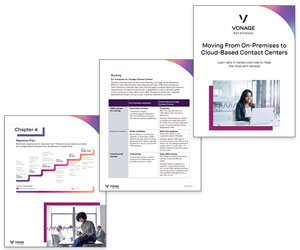An Interactive Voice Response system can be a great way to filter customers through to the right agent, but it’s easy to get it wrong. Here are the most common pitfalls.
Mistake #1: Overloading the caller with lengthy pre-queue introductions
You shouldn’t overload the caller with lengthy pre-queue introductions and lists of things they should have to hand.
If your call centre is adequately staffed, they won’t be able to retrieve any items before you answer the call and it’ll just annoy them.
Mistake #2: Having less than 2 on-hold messages
You should never have less than two on-hold messages, preferably three, since listening to the same message every thirty seconds drives callers insane.
It is best to have some variety.
Mistake #3: Providing unnecessary menu options
Don’t have unnecessary menus or menu options.
If several options lead to the same place, dispense with them and your callers will be a little happier when they do talk to you.
With thanks to Simon Beeching at Syntec
Mistake #4: Ignoring a customer’s prior interactions
Deliver personal messages to customers based on their previous engagements, before routing the call to the appropriate agent.
Traditionally, prior interactions with a company are never taken into account when a customer calls a service line. So regardless of whether you’ve just spent thousands of pounds and are just checking your order, or have had a previously poor experience, you’re expected to go through the same recorded messaging service as everyone else.
By reviewing previous caller experiences and serving a personal message or IVR menu, the customer experience is vastly improved.
With thanks to Jonathan Gale at NewVoiceMedia
Mistake #5: Forgetting to provide an exit route
You shouldn’t forget to give customers an exit route.
It can be easy to select the wrong option or go through and find you’ve just not selected the most relevant, at which point it’s too late and real frustration can set in.
Mistake #6: Ignoring the need to reassure your customers
One reason customers dislike IVR is they lack confidence in dealing with a machine. You need to do all you can to reassure them that their query or transaction is being processed.
Use multimedia notifications via text or email to follow up and give them that reassurance that even though they haven’t spoken to a real person, they are being dealt with.
Mistake #7: Settling for a limited functionality IVR system

David Ford
Don’t make do with limited functionality in your IVR system. There’s so much you can still do to improve the customer experience even when you don’t have an agent on the other end of the line.
That means intelligent routing and even transaction processing. It is entirely possible to process PCI-compliant credit card payments through an IVR system, meaning your contact centre can still be doing business even after you’ve shut up shop for the day.
With thanks to David Ford, Managing Director at Magnetic North
Mistake #8: Playing on-hold music that annoys callers
Playing bad – or boring – on-hold music that annoys callers and doesn’t reflect the brand image is a big mistake.
Mistake #9: Using different voices and volumes throughout the IVR experience
Do not use different voices and volumes for your prompts.
Changes in pitch, timbre and volume are jarring to the caller. It’s the audio equivalent of a website that goes from a red background to purple and then orange.
Mistake #10: Using industry jargon
Do not use industry jargon.
Get someone who doesn’t know your business to test the IVR.
Mistake #11: Creating an IVR jail with no option to request a call-back
Do not create IVR jail. You cannot serve all callers with IVR so you must let them get to a person or at least request a call-back.
Mistake #12: Exceeding 5 options in a push menu
Do not exceed 5 options in a push button menu.
The human memory runs out of capacity at this point. Consider using speech recognition if you have a lot of options.
Mistake #13: Designing your own IVR
Do not design your own IVR. Use a professional.
You wouldn’t let each department design its own website. This is a public interface to your organisation.
Mistake #14: Trying to make the IVR sound like a person
Don’t try to make the IVR sound like a person.

Tony Norman
It’s a machine and if it acts like one the caller will rate their expectations accordingly.
Also, don’t be too clever or wacky with the prompts. Or overuse “OK” and “thank you”, as this can sound as false as “have a nice day”.
With thanks to Tony Norman, Solutions Architects Manager at Netcall
Mistake #15: Asking a customer to start again
The top rules for me are:
- Always keep customer information when you drop to an advisor (never ask them to start again).
- Give the option to interrupt an instruction, speed through options or speak to an advisor whenever a customer desires.
- No more than 2 levels of options.
- Never ever loop a customer to the same option (when they’re lost or stuck, give them help).
- Never mismatch different voices when you go through menu options.
- Build a memory bank of customer details with non-complex needs, e.g. cards for paying.
- Invest in better sound quality and choice for both music and voice.
- Introduce open questions (Barclaycard seem to have the best IVR I’ve come across).
With thanks to Simon
Mistake #16: Thinking that your IVR is finished
Never think that your IVR is finished.
While you may start out with clear objectives, over time people move on, those objectives get forgotten and what was a great user experience turns into an IVR nightmare.
There’s a constant need to remove and add new options and even applications. So, how you’ll manage change should be considered at the same time as your IVR is implemented.
Mistake #17: Turning your IVR into a lawyer that spouts compliance messages
Don’t turn your IVR into a lawyer. While IVRs are great for compliance messages, as they never forget to say them and their time costs next to nothing (compared with an advisor), you should think carefully about when and how regulation messages are used. Especially if they’re not essential.
Also, try not to use legalese. It’s confusing, long-winded and leaves customers feeling like they’re on trial.
Mistake #18: Forgetting to measure and manage your IVR
Forgetting to measure and manage your IVR is a sin.
Think of your IVR as one of your team and come up with measures for it that are aligned to your contact centre or organisational objectives.
It’s not going to be easy to set these (agreeing measures is a challenge in its own right), or to actually get the information for these (measuring transfers caused by incorrect routing and what effect your IVR is having on satisfaction scores is a puzzle your MI team won’t thank you for).
But if you don’t measure your IVR’s performance how will you ever know if it’s good? And how will you fix the things that make it bad?
Mistake #19: Redirecting customers back to your website
Never send customers back to where they came from. Your message telling callers that they should try your website will not go down well.
In many cases they’ve already been online. So you’re just preaching to the converted. It’s no bad thing to promote digital channels. But deflection messages need to be carefully crafted, positioned well and include a clear benefit to the caller (not you) to encourage them to hang up.
Mistake #20: Forgetting about the end-to-end customer journey
Never create any part of your customers’ journeys in isolation. Think about how your greeting, IVR, pre-advisor messages, in-queue productions and even your on-hold music work together.

Fran Fish
Also, consider how they fit with the rest of the customers’ experience from what happens when they talk to advisors, to the mail / emails they receive and even what’s happening on your website.
Making your customers’ journeys better is about understanding where each part fits in the overall process, but also making sure that your brand is consistently supported.
With thanks to Fran Fish, Managing Director at SOH
Mistake #21: Not keeping the caller informed with regular updates of their position
For me it is about knowing how many people are in the queue and my estimated wait time. This puts me in control of the decision to hang on or call back.
Hanging on with no information regarding waiting time is one of the most frustrating things going. Keep the caller informed, give them regular updates of their position and estimated waiting time. This simple choice empowers the caller.
With thanks to Alan
Mistake #22: Over-estimating people’s attention spans
Don’t over-estimate people’s attention spans – make sure your IVR messages are short.
People want answers fast, so providing lengthy messages with lots of detail will annoy your customers. Just tell them the information they need to know with alternative ways to contact you.
Mistake #23: Leaving the important information until last
Don’t leave the important information until last. People need help quickly, so if you are telling them useless information at the beginning of your IVR message with the important information right at the end, chances are they won’t stick around long enough to hear the rest of it.
Customers will just end up frustrated, and they could end up choosing another supplier.
Mistake #24: Speaking too fast or too slowly
Don’t speak too fast or too slowly. Make sure you keep your messages at a pace that everyone can understand.
If you speak too quickly in your messages, customers may not get all the information they need, and they will get frustrated if they have to listen to the message lots of times as they haven’t heard the information correctly.
This is particularly important if you are giving a phone number. At the same time, don’t speak patronisingly slowly, as customers could lose interest.
Mistake #25: Overdoing the niceness

Richard McCrossan
Don’t overdo the niceness. You should make sure your IVR messages are nice – as well as helpful – explaining to the customer that their call is important, but you are busy with other customers, and there are maybe alternative ways they can get in touch.
Anything above and beyond this could sound false, and may end up annoying your customers even more.
With thanks to Richard McCrossan, Strategic Business Director at Genesys
Mistake #26: Not getting the customer to the right human contact as quickly as possible
I’ve wrangled over this one for years in previous roles. For me it’s always been about getting the customer to the right human contact as quickly as possible. I always come back to as few options and layers as possible.
With thanks to Ian
Mistake #27: Forcing customers to navigate the IVR to learn the contact centre is closed
Top of the list for ‘most annoying’ for customers is when they have rung up, got through, been asked a series of questions, pressed several buttons to get to the right person – and then the automated message informs them that the business is closed and to call back another time.
It is unforgivable – get it sorted by programming your IVR system correctly.
Mistake #28: Being unclear about where the menu options will lead
Make absolutely sure that the menu directing customers does, in fact, direct them to the place/person it says it does.
Often, the setting parameter is too generalised or the wording of the menu choices is not clear. If this is the case, it’s sometimes better not to have a menu at all. Fail on this one and it’s guaranteed to make customers angry – and waste valuable time.
Mistake #29: Playing inappropriate on-hold messages

Ken Reid
It can be comforting to hear messages when you’re stuck in a queue but make sure they are appropriate – hearing a sales pitch while waiting to make a complaint might not go down too well.
And make sure music isn’t being played too loudly – customers have been known to hang up for less!
With thanks to Ken Reid at Rostrvm Solutions
Mistake #30: Thinking that everyone loves vanilla
The reality is that not everyone loves vanilla. Callers to IVRs have unique needs, and the centres they call have unique skills and set-ups.
So copying your neighbour with the same voice, language and options won’t work in the long term. Again, it partly explains why there are so many poorly designed IVRs.
Mistake #31: Not giving your IVR a real personality
The bland female voice; the clichéd confusing repetitive language; the feeling that you’re lost in a telephony abyss; option after option. Sound familiar?
Unsurprisingly, this leads to frustration, drop-outs and abandonment.
You should design the language, voice, and options of your IVR so that it appeals to your unique customers and gets results. People just want information that’s helpful, clear and right for their need.
Mistake #32: Forgetting to sell the benefits of the IVR to the caller
Compare ‘to go through to the automated payment lines press 1’ versus ‘for the easiest and quickest way to pay your bill press 1’.
IVRs designed properly should really benefit the caller, so highlight it! It may be that you can transact 24/7 via IVR, or perhaps it just means you get to avoid the queues.
Sell the benefit to the customer and they may actually listen and do what you need them to do!
Mistake #33: Not putting yourself in your callers’ shoes

Kevin Freeman
Call centres wonder why people aren’t pressing the right options or are complaining to the agent about the IVR, yet too often they’ve not experienced the IVR journey for themselves.
It’s only by really feeling what the customer goes through that you can define what works and what doesn’t.
With thanks to Kevin Freeman, Contact Centre Development Director at Premier Business Audio
Mistake #34: Overusing “we are exceptionally busy right now” messages
Messages such as “we are exceptionally busy right now” should be saved for those times when you are genuinely busier than normal, otherwise it will leave a poor impression of your organisation.
Using the message too often, and at all times of the day, tells your customers that you are either perpetually in crisis, are chronically understaffed, or simply don’t like to speak to your customers.
When a recorded message is absolutely necessary, be sure to include advice for the customer as to when it is best to call back.
Mistake #35: Providing 15 different menu choices
It is best practice to deliberately limit the options on your IVR menus, and ensure you include a good degree of flexibility in the options available.
This will prevent you from putting too many overly prescriptive options in place which will irritate your customers. No one wants to listen to 15 menu choices, especially if they don’t hear the one they want and have to listen through again!
With natural language voice recognition, you can also flatten menus and quickly route the customer to the correct agent, saving them from having to wade through level upon level of options.
Mistake #36: Asking the customer to repeat information at various stages

Stephen Wright
Too many contact centres ask the customer to key in or say various amounts of identifying information to the IVR (phone number, account number, etc.), only to have them repeat it all over again to the agent or when they are transferred to another department.
Why ask for the information if you will only ask for it again? Only information required to route the call or validate security should be asked for during IVR, and then it should be made available to the agent so they don’t have to ask for it again.
With thanks to Stephen Wright, Product Manager at Azzurri Communications
Mistake #37: Not matching the voice to the brand
For a brand, the first impression is vital.
Research has shown that people apply many human qualities to the voice they hear within the first few seconds and respond better if the voice matches the brand persona they are expecting.
Also machine-generated IVR messages create more cognitive challenges because they are harder to understand. The more natural the IVR, the higher the user acceptance and task completion rate!
With thanks to Katie
Mistake #38: Recording IVR messages at the last minute

Phil Anderson
Don’t leave recording a message to the last minute, especially for events you’ve known about in advance. For example, your customer won’t be impressed to hear your Christmas opening hours announced with the sound of the office party in the background.
Also ensure that you review all messages – especially your out-of-hours and emergency messages – at regular intervals throughout the year and update them professionally.
With thanks to Phil Anderson at Professional Planning Forum
Mistake #39: Structuring the dialogue around what the organisation wants to achieve
Too many automated answering systems structure the dialogue around what the organisation wants to achieve from routing and reporting.
This can easily cause confusion and caller dissatisfaction as it becomes too hard for them to determine the option that is most appropriate to their main call reason.
The trick is first to understand what you want from routing but then to present the dialogue to the customer in a way that makes most sense to them and their call reasons.
Mistake #40: Only targeting the automation of tasks that are of low value
The temptation is to only target the automation of tasks that are of low value to your organisation.

Peter Galloway
However, a core factor driving the success of any self-service solution is the ease that a potential user encounters in determining whether a self-service option will meet their needs.
For self-service to be successful, the customer needs to be able to identify clearly what it is they are looking for and then be confident that the task offered will meet that requirement. Unfortunately, that link is not always obvious.
With thanks to Peter Galloway at Sabio
Mistake #41: Using formal written English when drafting your IVR scripts
Don’t use formal written English when drafting your IVR scripts. Don’t use long words, industry terms or business speak either.
More callers will press the right button if you draft informal, spoken English. The script is arguably the most influential part of an IVR – so spend time getting it right.
Mistake #42: Offering a route to a live agent in your main menu
It’s counter-intuitive – but do NOT offer a route to a live agent in your main menu.
70%–80% of callers will take this option, thus rendering your IVR pointless. Decide to use either an IVR to divide call groups or live handlers. Never try to do both!
Mistake #43: Using a celebrity voiceover artist

Nick Herbert
Don’t use the celebrity voiceover artist your marketing department use for TV and radio adverts.
They’ll be very expensive, they won’t be around when you need to record a quick update and you never know when the tabloids might reveal an unexpected story…
With thanks to Nick Herbert, Director at Adexchange Media Limited
For more contact centre IVR language tips and product features, read our articles:
- How to Write the Best IVR Messages – With Examples
- How to Write an IVR Script – With an Example
- What to Look for When Buying an IVR
Author: Megan Jones
Published On: 2nd Jul 2014 - Last modified: 17th Dec 2024
Read more about - Technology, David Ford, Editor's Picks, Fran Fish, Genesys, Intrado, IVR Solutions, Jonathan Gale, Ken Reid, Maintel, Phil Anderson, Richard McCrossan, Rostrvm, Sabio, Syntec, The Forum, Vonage











































This is great article, never realised there was so much to an IVR
Great post, and there are some important things to remember here. especially to never think of the IVR as done. There is always room for improvement. But I think it would be important to not only think about how you can improve the time someone is on hold if you put them there, but make sure you are thinking about how you can take advantage of an IVR to reduce or eliminate the call queues altogether which would mitigate some of those mistakes/concerns. An IVR system can do a lot more than simply route phone calls.
Mistake #44 – Do not use your IVR to call count. There are simpler, easier ways to identify call demand drivers, without placing the burden on customers who will invariably interpret the reason as different to your intent.
Mistake # 45 If the option selected does not in turn differentiate the agent to receive the call, remove it! Example, energy utility with over 50 options in IVR,directed to 47 skill sets – matched to universal agents!!
Don’t handle technial service using IVR specially device owned service
Please check the spell for organization.
Is it ok to leave messages with customers by starting with why you are failing and then where you are from at the end?
I totally disagree with not letting a person route to a live handler in the first menu. If you don’t, this tells me as a customer that you 1. Do not give a the first flying fig about your customer. 2. You are cheap or an unsuccessful business and either cannot or will not to hire people who need jobs to feed their families, to take calls. It is a bullying tactic. “No, you can’t talk to an agent without jumping through six hoops. Watcha gonna do about it chump? I double dog dare you to hang up and pick another company to work with. We’re so important we don’t need your piddly business anyway.” That’s what it tells me. If you can’t afford to run a business in which you treat your customers like people rather than cattle, don’t be in business.
Yes! I am also interested on ivr system
We have gone from a live person phone service, to a IVR system, that forces customers to either go to our website to either search our knowledge base and/or submit a support ticket, and we have done an excellent job to streamline the process. Our support costs have been reduced 90%. Now this will not work for everybody, but we deal mainly with Generation X and Y. So in our case #19 does not apply, but I agree with everybody else. If somebody is so stubborn that they want a telephone call, then yes please buy from our competition, as we found that these customer’s are the ones you really don’t want.
This may be an older essay, but an interesting one still. I’ve more or less made my peace with IVRs, having worked alongside them for many years. The one thing that I disapprove of is queuing live agents through the IVR. I only call my phone company when I have questions about things that I don’t know. These questions absolutely never have anything to do with any automatable function (even search engines would fail for most of these questions). When I, like most customers in my situation, start pounding the 0 button, the IVR keeps saying ” I know you’d like to speak with someone, but maybe there’s something I can help you with?” I have to pound it 3 times before the system sheepishly grants my wish. In real life, there would be bloodshed. Once a customer has determined the need to speak to a person, the IVR should be hands off. The live agent should be trained to provide basic assistance for whatever calls come in instead of having billing and claims separate, for example.
Kan, “organisation” is the correct spelling in the UK.
The most irritating thing for me ( and maybe I am the only one ? ) I have a speech impediment which does not affect my ability to have clear conversations with a person, but none of the IVR or voice-recognition tech works for me. 10 years ago, most IVR systems would accept touch tones as an alternative, but the newer systems do not, making it near impossible for me to get a hold of a live person, or get any meaningful information. AT&T switched to an all IVR system (with no alternative for folks like me ) forcing me to cancel ALL of my companies AT&T contracts and move to a different provider ( a 3 million/year contract )
Brian
You are not the only one. Speech recognition systems often don’t like my West Country accent. Luckily they are going out of favour with most companies and more companies are bringing in digital channels such as LiveChat.
enjoyed the article and agree with most of what is stated – a good checklist for review of current implementation. Has anyone every looked at how to balance the customer expectation and operational efficiency – how long should one expect a customer to stay in the IVR before impacting customer satisfaction. Understand the quick to press 0 but when trying to automate the collection of basic data – what is the normal customer attention span before frustration sets in?